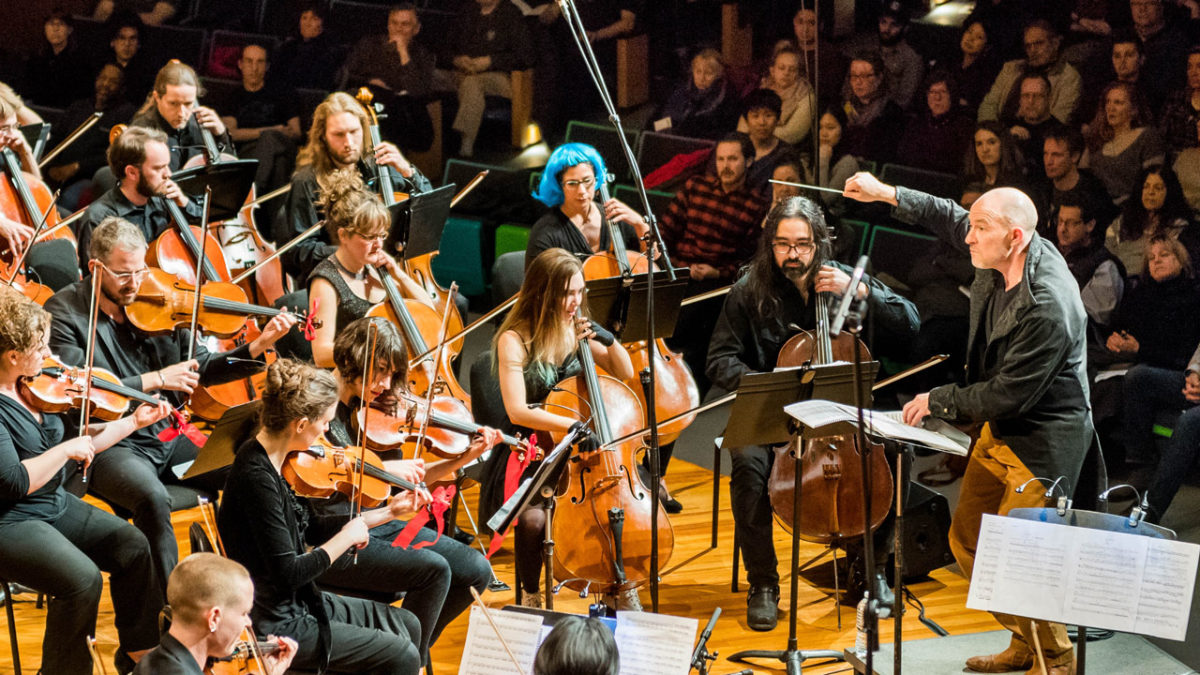Audiences experience Branca’s rarely-heard orchestral music and guitar ensemble.
September 20th marked the launch of the 2019-20 MIT Sounding series with the adventurous and often emphatically loud music of an American iconoclast. The Music of Glenn Branca Live: The Glenn Branca Ensemble/Ambient Orchestra gave Boston audiences a rare opportunity to hear Branca’s multi-faceted oeuvre, including his eponymous guitar ensemble, led by Reg Bloor, as well as seldom-heard orchestral compositions performed by the Ambient Orchestra, under the direction of Evan Ziporyn, faculty director of the MIT Center for Art, Science & Technology (CAST) and curator of the MIT Sounding series.
“This program introduces Boston audiences to Branca’s visionary scope,” says Ziporyn. “His exploration of the noise guitar influenced punk bands like Sonic Youth and led others to explore alternate guitar formats. Interestingly, it also informed his own orchestral compositions.” The concert presented both sides of Branca, demonstrating how deftly the pioneering composer applied his musical concepts across both classical and rock music, thereby bridging high and low aesthetics.
The Orchestral Side of Branca
Judging by a quick show of hands, many in the audience had heard Branca’s guitar ensemble, yet only a few people had experienced his orchestral music. The avid gathering seemed curious to hear two of Branca’s rarely-performed orchestral works: Free Form, followed by the first movement of Symphony No. 14: 2,000,000,000 Light Years from Home, both performed by the Ambient Orchestra, under Ziporyn’s direction.
Free Form, from Branca’s Symphony No. 7, is full of shifting polyrhythms and quicksilver meter changes, both signature elements of his compositions. In fact Free Form often seems excitingly out of sync—a polyrhythmic train that careens in and out of unison—as it propels forward. The complex rhythmic counter play requires careful listening by both the audience and the performers.
True to its title, the first (and only) movement of Branca’s Symphony No. 14: 2,000,000,000 Light Years from Home takes us on a far-flung musical journey through time and space, with the orchestra as our guide. The piece opens with a sustained, slow build, and suddenly stops—we are far from home. Moving through episodic sound clusters and tolling chimes, we descend down a sliding scale, finding strange new swarms of energy. At times, the orchestration emulates the sound of the pipe organ, bringing to mind the soundtrack to Stanley Kubrick’s 2001: A Space Odyssey. “It’s one of the most harmonically complex pieces I’ve ever done,” says Ziporyn.
The Ambient Orchestra deftly tackled Branca’s challenging scores, which Ziporyn found inspiring. “Today, classical musicians are more willing to embrace a broad range of music, and more capable of performing across genres.”
The Glenn Branca Ensemble
The Glenn Branca Ensemble took the stage for the program’s second half, performing the soon-to-be-released The Third Ascension. This was the ensemble’s first performance since the composer’s passing in 2018. The group is led by experimental avant-rock guitarist Reg Bloor, Branca’s concertmaster and right hand since 2000.
Branca’s guitar music has a reputation for being dangerously loud, an idea that began in the 1980s with his ensembles of 100 or more guitars, who performed in acoustically volatile spaces like the Anchorage under the Brooklyn Bridge, says Bloor. But, she adds, “A lot of guitars doesn’t necessarily mean loud.”
In fact, the Glenn Branca Ensemble’s four guitarists, bassist and drummer make a lot of noise. The music’s defiant volume can be repelling on a visceral level, but those who go there find sonic riches. The group filled Kresge Hall with a flood of sound, brimming with overtones, microtones and melody, driven by the relentlessly powerful drumming of Libby Fab. Conductor Brendon Randall-Myers adopted Branca’s signature wide-legged stance, cueing the ensemble with large and dramatic gestures, giving the audience a good show.
The set’s six movements from The Third Ascension featured Bloor’s shredding guitar solo in “German Expressionism” and longtime Branca guitarist Arad Evans in “The Smoke (Guitar Concerto for Arad Evans)”.
The Third Ascension employs some of Branca’s classic guitar techniques, including close to the bridge tremolos that create a smoother sound. “Glenn had his own way of looking at things,” notes Bloor. “He was constantly coming up with new ideas for everything.” She recalls helping the composer notate his score for The Third Ascension from graph paper to staff notation, which he preferred to give the musicians..
The set ended with “Cold Thing”, a full out audio experience that includes dramatic drops in volume as it reaches ever higher, with surging intensity. The piece culminates at a sound level that, fittingly, seemed beyond comprehension, even for Branca.



